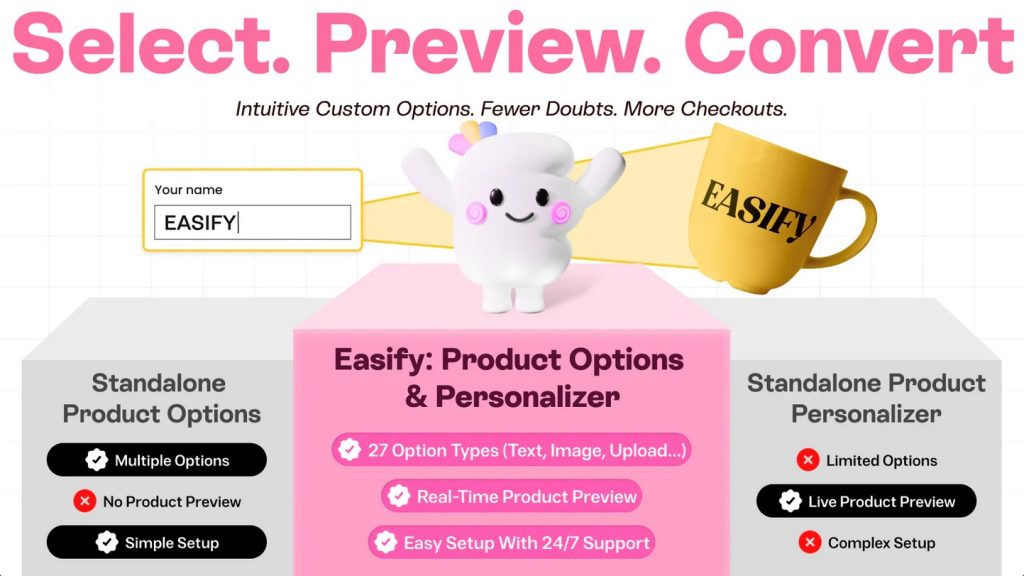Setting up products in Shopify might seem straightforward at first—but when it comes to customization and variations, things can get confusing. Store owners often struggle to understand the difference between product options and product variants, and choosing the wrong approach can lead to inventory headaches, pricing issues, or a confusing shopping experience for customers.
In this post, we’ll break down the difference between Shopify product options and variants, as well as exploring their limitations. Plus, we’ll introduce a powerful solution that lets you go beyond Shopify’s limits and offer unlimited product customization.
By the end, you’ll know exactly how to set up your products so your customers get a seamless shopping experience—and you get full control over inventory, pricing, and personalization.
What Are Shopify Product Options?
Product options in Shopify are the choices a customer can select when customizing a product. They represent the basic attributes of a product, such as size, color, material, or style. For example, a T-shirt might offer the options Size (Small, Medium, Large) and Color (Blue, Black, White).
Each product on Shopify can have up to three options, and while Shopify allows multiple values within each option, there is a limit of how many options can exist per product. By themselves, options do not control stock or pricing—they simply define the inputs that help generate product variants.
Examples of Shopify product options
A pair of shoes with options for:
- Size
- Color
A ring with options for:
- Metal type
- Engraving text
In many cases, product options alone are enough—especially if you’re selling items that don’t require inventory tracking for every possible combination. For example, if a personalized notebook only needs a dropdown for cover style and a text box for engraving, you might not need full variants at all.
When do product options make sense?
Use options when:
- All versions of the product share the same price
- You don’t need separate inventory tracking for each choice
- You want customers to select custom details without generating dozens of variant combinations
In short, product options define what a customer can choose, and they’re the foundation for product customization in Shopify. Variants take things a step further—turning those options into actual sellable product combinations with pricing, inventory tracking, and SKU management (which we’ll cover next).
What Are Shopify Product Variants?

Shopify product variants are the actual purchasable combinations created from your product options. While options define the attributes (like size or color), variants represent the specific version of the product a customer buys—such as “Medium / Blue” or “Large / Red.”
Each variant in Shopify can have its own:
- SKU
- Individual price
- Inventory level
- Barcode
- Image
- Weight and shipping details
This makes variants essential for products where different versions need to be tracked or sold separately.
How variants work
If you have a product with two options:
- Size (S, M, L)
- Color (Blue, Black)
Shopify automatically generates all combinations, resulting in 6 variants:
- Small / Blue
- Small / Black
- Medium / Blue
- Medium / Black
- Large / Blue
- Large / Black
Each of these can be edited individually, giving merchants complete control over how each version behaves in the catalog and checkout.
We have a dedicated article on this topic, give it a read if you want to learn more.
Further reading: How Do Shopify Variants Work?
Shopify’s variant limits
There are two important platform constraints:
- Up to 3 options per product
- Up to 2048 total variants per product
If you exceed these limits—common with complex products like configurable gadgets, custom furniture, or personalized items—you may need a product options app or customization tool.
When product variants are necessary
Variants make sense when:
- Each version needs its own inventory tracking
- Different options require different pricing
- You want to display different images for different selections
- You use barcodes, SKUs, or fulfillment systems
Examples of products that rely on variants
- T-shirts with different sizes and colors
- Shoes where each size has its own inventory
- Jewelry available in multiple metals and gemstones
- Phone accessories that cost more for larger models
In short, variants are the sellable outcomes of product options, giving merchants the flexibility to manage each version of a product independently while offering customers a smoother buying experience.
Shopify Product Options vs Variants: Key Differences
While options and variants are closely related, they play very different roles in how products are configured and sold on Shopify. Options define what choices the customer sees—like size or color—while variants represent the specific combinations they can actually purchase. The biggest difference is that variants allow individual control over pricing, inventory, images, and fulfillment, while options do not.
The table below breaks down the major differences at a glance:
| Criteria | Product Options | Product Variants |
|---|---|---|
| What they are | Attributes customers choose (e.g., Size, Color) | Actual purchasable combinations generated from options |
| Examples | Size, Material, Engraving text | “Medium / Blue,” “Large / Silver” |
| Limit per product | Max of 3 options | Max of 2048 variants |
| Inventory control | Not tracked per option | Each variant can track its own stock |
| Separate SKU or barcode | Not supported | Each variant can have unique SKU/barcode |
| Individual pricing | All options share same price | Each variant can have its own price |
| Images per selection | Not applied per option | Each variant can have a specific image |
| Shipping weight and details | Shared across the product | Configurable per variant |
| When it’s best | Simple products or no need for inventory splits | Products with inventory, pricing, or fulfillment differences |
What If You Need More Options or Variants?
While Shopify’s native product setup works well for many stores, the built-in limits can quickly become restrictive—especially for customizable or multi-attribute products. Shopify allows a maximum of 3 options per product, which means complex items like configurable furniture, engraved jewelry, gift sets, or customizable apparel can easily exceed these limits.
If you run into this situation, you’ll need a solution that goes beyond Shopify’s defaults and gives you the flexibility to create as many input fields and customization choices as your product requires.
A Better Solution: Easify Custom Product Options

If you need more than Shopify’s native structure allows, Easify Custom Product Options is one of the most powerful ways to expand your product customization capabilities without adding multiple product listings or complex workarounds.
Easify lets you create unlimited product options and advanced personalization tools directly on the product page, including:
- Text fields and custom input boxes
- Image and color swatches
- Dropdowns, radio buttons, and checkboxes
- File and image upload
- Custom size fields (height, width, depth)
- Date, time, font, and color pickers
Unlike basic option apps, Easify is built to increase conversions and sales, not just display additional fields. You can:
- Add product or price-based add-ons for upselling
- Use conditional logic to show options based on customer selections
- Link add-ons directly to other products
- Offer live preview personalization, so customers see their engraving, uploaded image, or text update in real time
If you want to offer deeper customization, unlimited options, or more flexible product personalization, try Easify Custom Product Options and deliver the kind of buying experience customers love—without the headaches of Shopify’s built-in limits.



